kottke.org posts about usa
Leo Tolstoy probably wasn’t thinking of an American Thanksgiving when he opened Anna Karenina with this line: “Happy families are all alike; every unhappy family is unhappy in its own way.” These days, all families — happy or not — are less alike than ever. In the NYT, Natalie Angier takes a look at the changing definition of family:
Families are more ethnically, racially, religiously and stylistically diverse than half a generation ago — than even half a year ago. In increasing numbers, blacks marry whites, atheists marry Baptists, men marry men and women women, Democrats marry Republicans and start talk shows.
And they’re all coming over to your house for Thanksgiving, which brings us to another quote — this one from Oscar Wilde: “After a good dinner one can forgive anybody, even one’s own relations.”
Buzzfeed asked some Brits to label states on a US map. They didn’t do so well:
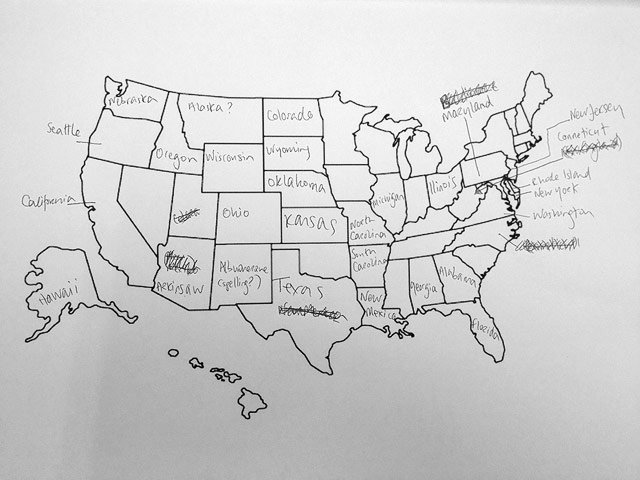
My favorite is “Further South Dakota”. In fairness, most US citizens would be hard pressed to name any of the counties of England, much less place them on a map.
Update: See how Americans fared on placing European countries. (Not well.)
You’ve likely seen the various dialect maps of the US…the Coke/soda/pop maps. The Atlantic Video team did a wonderful thing with them…they called native speakers around the country and asked them to pronounce some of the words featured on these maps.
It’s one thing to read the difference between the pronounciations of “route”, it’s another thing entirely to hear them. I haven’t lived in the Midwest since 2000 and I have since transitioned from “pop” to “soda”, “waiting in line” to “waiting on line”, and am working on switching to “sneakers” from “tennis shoes” (or even “tennies”). But I was surprised to learn that I still pronounce “bag” differently than everyone else!
Writing in the Times, Frank Bruni notes the increasing tendency in the US to provide various levels of service for money.
Much has been made of commercial flights these days, with all those divisions between first class and coach. For various supplements or with various deals, you can get a few more inches of legroom or, shy of that, a prime aisle seat. You can get to board earlier or later, and thus hoard or miss out on the overhead bins. Will it be long before there’s a ranked queue for the bathroom? I’m not even sure I’m kidding.
It’s not that pecking orders or badges of affluence are anything new. Our homes, cars, clubs and clothes have long been advertisements of our economic clout, used and perceived that way.
But lately, the places and ways in which Americans are economically segregated and stratified have multiplied, with microclimates of exclusivity popping up everywhere. The plane mirrors the sports arena, the theater, the gym. Is it any wonder that class tensions simmer? In a country of rising income inequality and an economy that’s moved from manufacturing to services, one thing we definitely make in abundance is distinctions.
Reminds me of Tom Junod’s piece in Esquire about waiting in line as an expression of American democracy.
Apparently, an Englishman named Leonard Sim took his family to Disneyland a few years ago, and his vacation was ruined by waiting in line. He invented something called the Flash Pass, and then sold it to an English company called Lo-Q — as in “Low Queue” — which contracted it to Whitewater. So now, when you go to Whitewater and many other American amusement parks, you pay for parking ($15, at Whitewater), and then for admission ($37.50, for any human being over 48 inches tall), and finally for a locker ($16), and then, once you’re inside, you can pay an extra $30 for a “standard” Flash Pass or $40 for the “gold.” And then you can cut the lines.
It sounds like an innovative answer to the problem that everybody faces at an amusement park, and one perfectly in keeping with the approaches currently in place at airports and even on some crowded American highways — perfectly in keeping with the two-tiering of America. You can pay for one level of access, or you can pay for another. If you have the means, you can even pay for freedom. There’s only one problem: Cutting the line is cheating, and everyone knows it. Children know it most acutely, know it in their bones, and so when they’ve been waiting on a line for a half-hour and a family sporting yellow plastic Flash Passes on their wrists walks up and steps in front of them, they can’t help asking why that family has been permitted the privilege of perpetrating what looks like an obvious injustice. And then you have to explain not just that they paid for it but that you haven’t paid enough — that the $100 or so that you’ve ponied up was just enough to teach your children that they are second- or third-class citizens.
This month, Smithsonian magazine tells the story of America using 101 objects drawn from the 19 musuems and research centers of the Smithsonian Institution. Among the objects are the original Star Spangled Banner flag, the passenger pigeon, the polio vaccine, the pill, and Benjamin Franklin’s Experiments and Observations on Electricity.
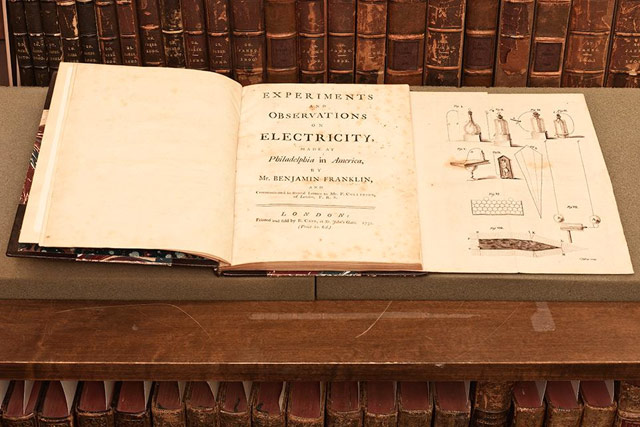
A companion book, The Smithsonian’s History of America in 101 Objects, is available.
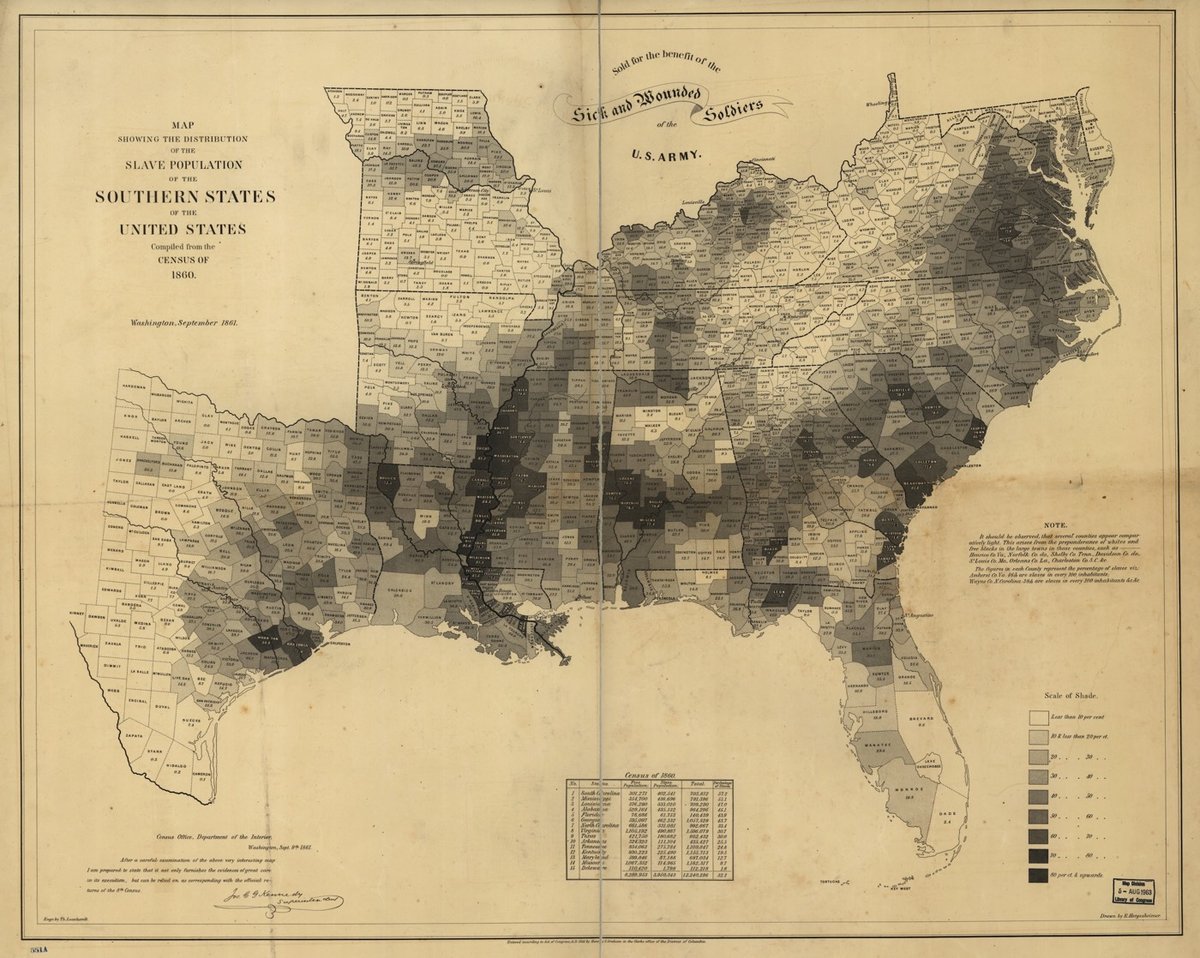
Using data from the 1860 US Census, the Department of the Interior made this map showing the percentages, by county, of the slave population of the southern states.
Though this map was simple, it showed the relationship between states’ commitment to slavery and their enthusiasm about secession, making a visual argument about Confederate motivations.
Schulten writes that President Lincoln referred to this particular map often, using it to understand how the progress of emancipation might affect Union troops on the ground. The map even appears in the familiar Francis Bicknell Carpenter portrait First Reading of the Emancipation Proclamation of President Lincoln, visible leaning against a wall in the lower right-hand corner of the room.
Here’s a larger version. The numbers in some locations are staggering and sickening — in many counties 75% of the population was enslaved and the rate is over 90% in a few places.
For the Journal of the American Revolution, Todd Andrlik compiled a list of the ages of the key participants in the Revolutionary War as of July 4, 1776. Many of them were surprisingly young:
Marquis de Lafayette, 18
James Monroe, 18
Gilbert Stuart, 20
Aaron Burr, 20
Alexander Hamilton, 21
Betsy Ross, 24
James Madison, 25
This is kind of blowing my mind…because of the compression of history, I’d always assumed all these people were around the same age. But in thinking about it, all startups need young people…Hamilton, Lafayette, and Burr were perhaps the Gates, Jobs, and Zuckerberg of the War. Some more ages, just for reference:
Thomas Jefferson, 33
John Adams, 40
Paul Revere, 41
George Washington, 44
Samuel Adams, 53
The oldest prominent participant in the Revolution, by a wide margin, was Benjamin Franklin, who was 70 years old on July 4, 1776. Franklin was a full two generations removed from the likes of Madison and Hamilton. But the oldest participant in the war was Samuel Whittemore, who fought in an early skirmish at the age of 80. I’ll let Wikipedia take it from here:
Whittemore was in his fields when he spotted an approaching British relief brigade under Earl Percy, sent to assist the retreat. Whittemore loaded his musket and ambushed the British from behind a nearby stone wall, killing one soldier. He then drew his dueling pistols and killed a grenadier and mortally wounded a second. By the time Whittemore had fired his third shot, a British detachment reached his position; Whittemore drew his sword and attacked. He was shot in the face, bayoneted thirteen times, and left for dead in a pool of blood. He was found alive, trying to load his musket to fight again. He was taken to Dr. Cotton Tufts of Medford, who perceived no hope for his survival. However, Whittemore lived another 18 years until dying of natural causes at the age of 98.
!!!
Perhaps inspired by All Streets, Ben Fry’s map of all the streets in the US, Nelson Minar built a US map out of all the rivers in the country.


Minar put all the data and files he used up on Github so you can make your own version.
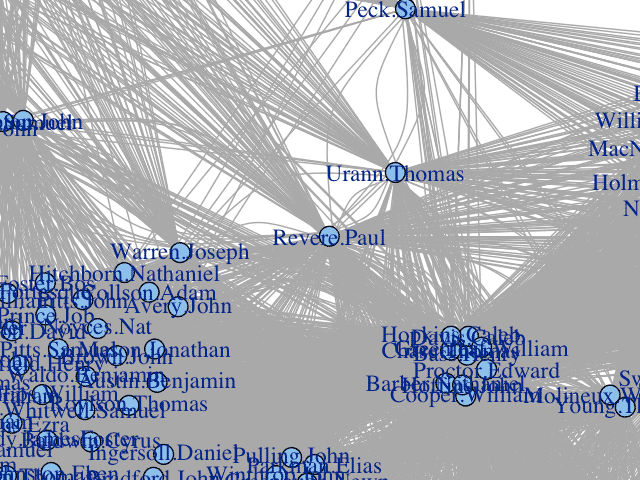
There’s been a lot of discussion recently about government programs like PRISM and how, according to defenders of such surveillance, they “only” collect metadata related to communications and not the content of the communication. In a clever article, Kieran Healy uses only the membership lists of various Boston-area organizations in the late 1770s to find out quite a lot about who might be the leaders of the nascent revolutionary cell. Even with this simple analysis, Paul Revere’s name pops out of the data.
The analytical engine has arranged everyone neatly, picking out clusters of individuals and also showing both peripheral individuals and-more intriguingly-people who seem to bridge various groups in ways that might perhaps be relevant to national security. Look at that person right in the middle there. Zoom in if you wish. He seems to bridge several groups in an unusual (though perhaps not unique) way. His name is Paul Revere.
Once again, I remind you that I know nothing of Mr Revere, or his conversations, or his habits or beliefs, his writings (if he has any) or his personal life. All I know is this bit of metadata, based on membership in some organizations. And yet my analytical engine, on the basis of absolutely the most elementary of operations in Social Networke Analysis, seems to have picked him out of our 254 names as being of unusual interest.
Now, the Crown may have suspected Revere of anti-Royalist leanings without this analysis. But with the analysis, they all but know. Get Revere and a few other highly connected nodes into jail on some trumped-up charges and, voila, maybe the American Revolution never happens or is quickly quashed. Revere and the American Revolution is an extreme example of what Moxie Marlinspike is getting at in We Should All Have Something To Hide: that breaking the law is sometimes how society moves forward.
Over the past year, there have been a number of headline-grabbing legal changes in the US, such as the legalization of marijuana in CO and WA, as well as the legalization of same-sex marriage in a growing number of US states.
As a majority of people in these states apparently favor these changes, advocates for the US democratic process cite these legal victories as examples of how the system can provide real freedoms to those who engage with it through lawful means. And it’s true, the bills did pass.
What’s often overlooked, however, is that these legal victories would probably not have been possible without the ability to break the law.
The state of Minnesota, for instance, legalized same-sex marriage this year, but sodomy laws had effectively made homosexuality itself completely illegal in that state until 2001. Likewise, before the recent changes making marijuana legal for personal use in WA and CO, it was obviously not legal for personal use.
Imagine if there were an alternate dystopian reality where law enforcement was 100% effective, such that any potential law offenders knew they would be immediately identified, apprehended, and jailed. If perfect law enforcement had been a reality in MN, CO, and WA since their founding in the 1850s, it seems quite unlikely that these recent changes would have ever come to pass. How could people have decided that marijuana should be legal, if nobody had ever used it? How could states decide that same sex marriage should be permitted, if nobody had ever seen or participated in a same sex relationship?
What if journalists from foreign countries wrote about the US the way US newspapers and magazines cover events in foreign countries?
On a recent visit to the United States by GlobalPost, signs of the increased security apparatus could be found everywhere.
At all national airports, passengers are now forced to undergo full-body scans before boarding any flights. Small cameras are perched on many street corners, recording the movements and actions of the public. And incessant warnings on public transportation systems encourage citizens to report any “suspicious activity” to authorities.
Several American villagers interviewed for this story said the ubiquitous government marketing campaign called, “If you see something, say something,” does little to make them feel safer and, in fact, only contributes to a growing mistrust among the general population.
“I’ve deleted my Facebook account, stopped using email, or visiting websites that might be considered anti-regime,” a resident of the northern city of Boston, a tough-as-nails town synonymous with rebellion, told GlobalPost. It was in Boston that an American militia first rose up against the British empire. “But my phone? How can I stop using my phone? This has gone too far.”
In a book called Three Felonies A Day, Boston civil rights lawyer Harvey Silverglate says that everyone in the US commits felonies everyday and if the government takes a dislike to you for any reason, they’ll dig in and find a felony you’re guilty of.
The average professional in this country wakes up in the morning, goes to work, comes home, eats dinner, and then goes to sleep, unaware that he or she has likely committed several federal crimes that day. Why? The answer lies in the very nature of modern federal criminal laws, which have exploded in number but also become impossibly broad and vague. In Three Felonies a Day, Harvey A. Silverglate reveals how federal criminal laws have become dangerously disconnected from the English common law tradition and how prosecutors can pin arguable federal crimes on any one of us, for even the most seemingly innocuous behavior. The volume of federal crimes in recent decades has increased well beyond the statute books and into the morass of the Code of Federal Regulations, handing federal prosecutors an additional trove of vague and exceedingly complex and technical prohibitions to stick on their hapless targets. The dangers spelled out in Three Felonies a Day do not apply solely to “white collar criminals,” state and local politicians, and professionals. No social class or profession is safe from this troubling form of social control by the executive branch, and nothing less than the integrity of our constitutional democracy hangs in the balance.
In response to a question about what happens to big company CEOs who refuse to go along with government surveillance requests, John Gilmore offers a case study in what Silverglate is talking about.
We know what happened in the case of QWest before 9/11. They contacted the CEO/Chairman asking to wiretap all the customers. After he consulted with Legal, he refused. As a result, NSA canceled a bunch of unrelated billion dollar contracts that QWest was the top bidder for. And then the DoJ targeted him and prosecuted him and put him in prison for insider trading — on the theory that he knew of anticipated income from secret programs that QWest was planning for the government, while the public didn’t because it was classified and he couldn’t legally tell them, and then he bought or sold QWest stock knowing those things.
This CEO’s name is Joseph P. Nacchio and TODAY he’s still serving a trumped-up 6-year federal prison sentence today for quietly refusing an NSA demand to massively wiretap his customers.
You combine this with the uber-surveillance allegedly being undertaken by the NSA and other governmental agencies and you’ve got a system for more or less automatically accusing any US citizen of a felony. Free society, LOL ROFLcopter.
Update: For the past two years, the Wall Street Journal has been “examining the vastly expanding federal criminal law book and its consequences”. (thx, jesse)
Joshua Katz has been studying American dialects and has made more than 120 maps of some of the differences in American speech. Here are a few examples:
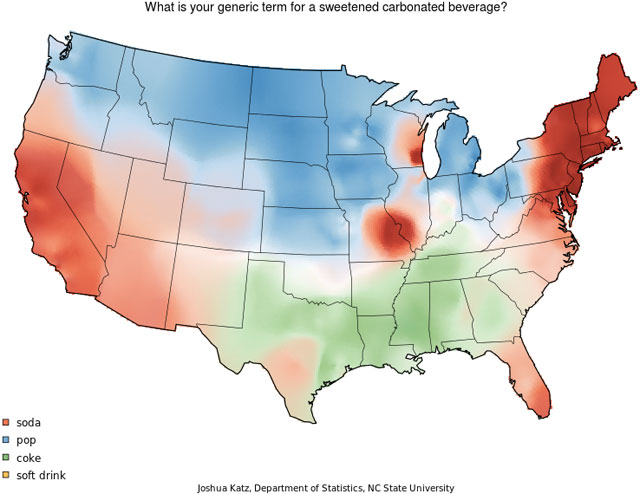
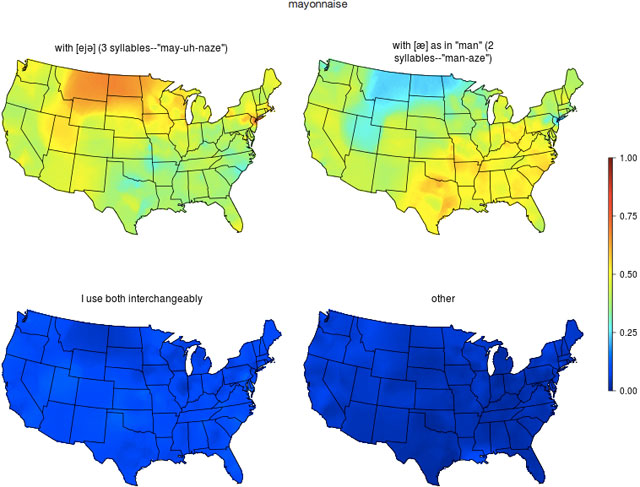
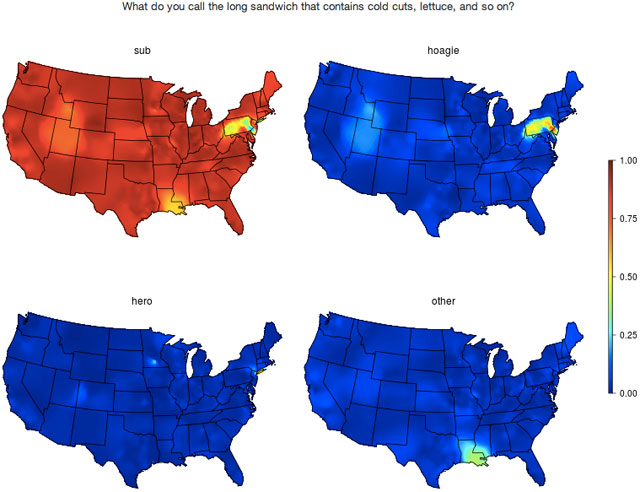
(thx, everyone)
Update: As he notes on the site, Katz’s maps are based on the research and work of Bert Vaux…Vaux’s maps of the same data can be found here. (thx, molly, margaret, & nicholas)
Surprisingly entertaining article about better choices for the state birds of each of the 50 US states.
4. Arkansas. Official state bird: northern mockingbird
Christ. What makes this even less funny is that there are like eight other states with mockingbird as their official bird. I’m convinced that the guy whose job it was to report to the state’s legislature on what the official bird should be forgot until the day it was due and he was in line for a breakfast sandwich at Burger King. In a panic he walked outside and selected the first bird he could find, a dirty mockingbird singing its stupid head off on top of a dumpster.
What it should be: painted bunting
More hilarious science journalism, please. Yes, in addition to the excellent What If? (via @jessamyn)
“Give me your tired, your poor, your huddled masses yearning to breathe free.” And I’ll give them heart disease, high blood pressure, diabetes, and a shorter lifespan. A growing body of research suggests that there is often a high health toll when it comes to coming to America.
A growing body of mortality research on immigrants has shown that the longer they live in this country, the worse their rates of heart disease, high blood pressure and diabetes. And while their American-born children may have more money, they tend to live shorter lives than the parents.
The pattern goes against any notion that moving to America improves every aspect of life. It also demonstrates that at least in terms of health, worries about assimilation for the country’s 11 million illegal immigrants are mistaken. In fact, it is happening all too quickly.
The national rates of gun violence and homicide in the US have fallen significantly in past 20 years, but most people are unaware. From a recently released Pew Research report:
Nearly all the decline in the firearm homicide rate took place in the 1990s; the downward trend stopped in 2001 and resumed slowly in 2007. The victimization rate for other gun crimes plunged in the 1990s, then declined more slowly from 2000 to 2008. The rate appears to be higher in 2011 compared with 2008, but the increase is not statistically significant. Violent non-fatal crime victimization overall also dropped in the 1990s before declining more slowly from 2000 to 2010, then ticked up in 2011.
Despite national attention to the issue of firearm violence, most Americans are unaware that gun crime is lower today than it was two decades ago. According to a new Pew Research Center survey, today 56% of Americans believe gun crime is higher than 20 years ago and only 12% think it is lower.
The whys behind the drop in gun violence (and in crime in general) are more difficult to come by:
There is consensus that demographics played some role: The outsized post-World War II baby boom, which produced a large number of people in the high-crime ages of 15 to 20 in the 1960s and 1970s, helped drive crime up in those years.
A review by the National Academy of Sciences of factors driving recent crime trends (Blumstein and Rosenfeld, 2008) cited a decline in rates in the early 1980s as the young boomers got older, then a flare-up by mid-decade in conjunction with a rising street market for crack cocaine, especially in big cities. It noted recruitment of a younger cohort of drug seller with greater willingness to use guns. By the early 1990s, crack markets withered in part because of lessened demand, and the vibrant national economy made it easier for even low-skilled young people to find jobs rather than get involved in crime.
At the same time, a rising number of people ages 30 and older were incarcerated, due in part to stricter laws, which helped restrain violence among this age group. It is less clear, researchers say, that innovative policing strategies and police crackdowns on use of guns by younger adults played a significant role in reducing crime.
(via hacker news)
A list of the northernmost, southernmost, easternmost and westernmost cities/towns/villages in all 50 US states.
Vermont — Northernmost: Derby Line. Southernmost: Vernon (specifically South Vernon area). Easternmost: Beecher Falls. Westernmost: Chimney Point.
California — Northernmost: Tulelake (note: Fairport is more northerly but is considered a “former settlement”) Southernmost: San Diego (San Ysidro District). Easternmost: Parker Dam. Westernmost: Ferndale.
New York — Northernmost: Rouses Point. Southernmost: Staten Island-New York City (Tottenville Neighborhood) Easternmost: Montauk. Westernmost: Findley Lake.
(via @jessamyn)
US currency is already embarrassing and this new design for the $100 bill is not helping.
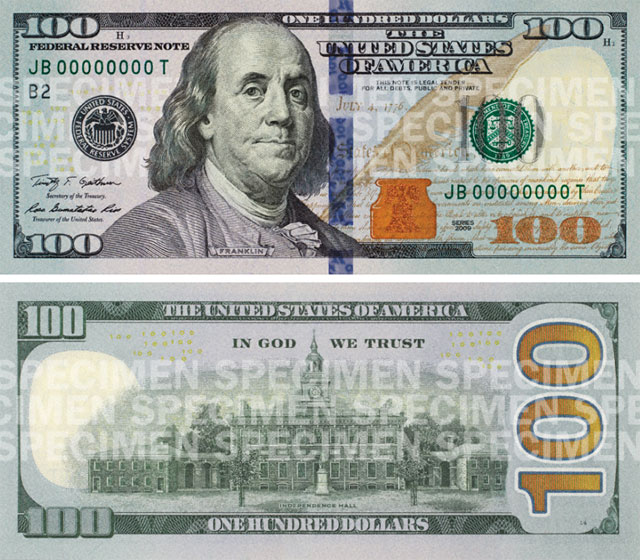
This may be worse than the horrible US passport.
After an exhaustive search, I have decided this photo most exemplifies life in these United States during the 1980s:

And if not that one, then one of several other possible candidates from Roger Minick’s Sightseer project, for which he took photos of tourists at popular US tourist destinations during the early 1980s and into the 2000s.
When I approached people for a portrait, I tried to make my request clear and to the point, making it clear that I was not trying to sell them anything. I explained that my wife and I were traveling around the country visiting most of the major tourist destinations so that I could photograph the activity of sightseeing. I would quickly add that I hoped the project would have cultural value and might be seen in years to come as a kind of time capsule of what Americans looked like at the end of the Twentieth Century; at which, to my surprise, I would see people often begin to nod their heads as if they knew what I was talking about.
Slate did a feature on this series last week.

If this photo series from 1950 of the interior of the White House being ripped out so that the building could be structurally reinforced isn’t an apt metaphor for the current state of American politics, I don’t know what is.
Experts called the third floor of the White House “an outstanding example of a firetrap.” The result of a federally commissioned report found the mansion’s plumbing “makeshift and unsanitary,” while “the structural deterioration [was] in ‘appalling degree,’ and threatening complete collapse.” The congressional commission on the matter was considering the option of abandoning the structure altogether in favor of a built-from-scratch mansion, but President Truman lobbied for the restoration.
“It perhaps would be more economical from a purely financial standpoint to raze the building and to rebuild completely,” he testified to Congress in February 1949. “In doing so, however, there would be destroyed a building of tremendous historical significance in the growth of the nation.”
So it had to be gutted. Completely. Every piece of the interior, including the walls, had to be removed and put in storage. The outside of the structure-reinforced by new concrete columns-was all that remained.
(via digg)
This Justice Department memo about when the US government, without hearing or trial or due process or whatever other “rights” we as a country hold dear, can kill US citizens is fucking bullshit.
A confidential Justice Department memo concludes that the U.S. government can order the killing of American citizens if they are believed to be “senior operational leaders” of al-Qaida or “an associated force” — even if there is no intelligence indicating they are engaged in an active plot to attack the U.S.
The 16-page memo, a copy of which was obtained by NBC News, provides new details about the legal reasoning behind one of the Obama administration’s most secretive and controversial polices: its dramatically increased use of drone strikes against al-Qaida suspects abroad, including those aimed at American citizens, such as the September 2011 strike in Yemen that killed alleged al-Qaida operatives Anwar al-Awlaki and Samir Khan. Both were U.S. citizens who had never been indicted by the U.S. government nor charged with any crimes.
The whole memo is here. A staggering disappointment from a man many think is better than this. See also: Obama’s lethal Presidency.
According to Google’s search tracking, this is the worst flu season in more than 6 years.
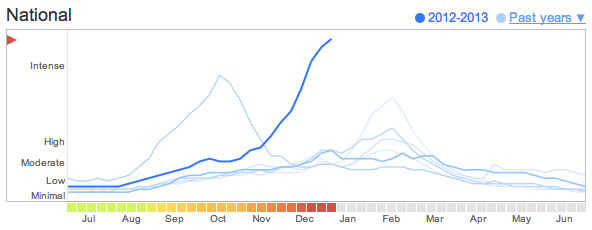
Google’s trends tend to follow the official CDC data closely and indeed the CDC concurs about the scope of the flu this year but their data is lagging behind Google’s by what looks like about 2 weeks. See also my post on how flu vaccines are made. (via @kellan)
During her reign, Queen Elizabeth II of England has met 10 sitting US Presidents, every one from Eisenhower to Obama except for Lyndon Johnson. She also met Harry Truman as a princess in 1951 and former President Herbert Hoover in 1957.
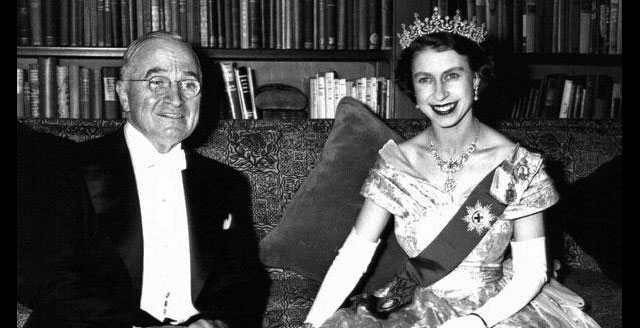

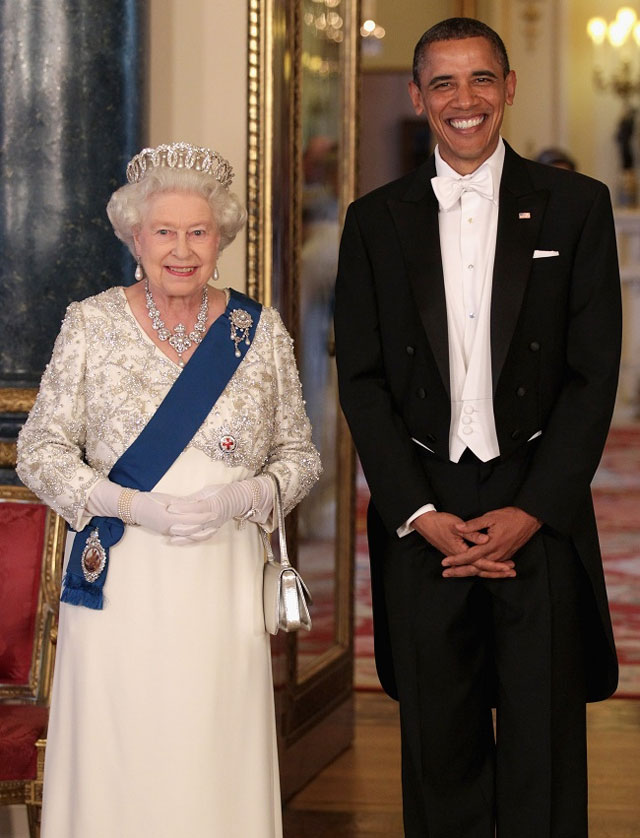
You can see the entire progression here or here. QEII is more definitely a human wormhole.
BTW, Elizabeth is creeping up on Queen Victoria as the longest-reigning British monarch, just another two-and-a-half years to catch her. Victoria reigned during the terms of 19 different Presidents but never met any of them and had an unfair advantage…lots of short terms and one-term Presidencies back then. (via mlkshk)
From Stone, the NY Times’ blog of philosophers writing about current events, a post by Firmin DeBrabander about what sort of society (polite? uncivil? safe?) an armed society is.
Arendt offers two points that are salient to our thinking about guns: for one, they insert a hierarchy of some kind, but fundamental nonetheless, and thereby undermine equality. But furthermore, guns pose a monumental challenge to freedom, and particular, the liberty that is the hallmark of any democracy worthy of the name — that is, freedom of speech. Guns do communicate, after all, but in a way that is contrary to free speech aspirations: for, guns chasten speech.
This becomes clear if only you pry a little more deeply into the N.R.A.’s logic behind an armed society. An armed society is polite, by their thinking, precisely because guns would compel everyone to tamp down eccentric behavior, and refrain from actions that might seem threatening. The suggestion is that guns liberally interspersed throughout society would cause us all to walk gingerly — not make any sudden, unexpected moves — and watch what we say, how we act, whom we might offend.
(via @TomJunod)
Jon Lee Anderson asks, in reference to mass shootings, “What does it take for a society to be sickened by its own behavior and to change its attitudes?”
When will we Americans realize that our society is an unacceptably violent one, that this is how the rest of the world sees us, and that much of that violence is associated with guns? Will it be the massacre at Sandy Hook Elementary School? Where is our threshold for self-awareness?
When God said in the Bible “you shall have no other gods before me”, one of the gods he was referring to was Moloch, an Ammonite god worshipped by the Phoenicians and Canaanites who was associated with the sacrifice of children by his followers. In a short essay for The New York Review of Books, Gary Wills singles out the gun as America’s Moloch.
Read again those lines, with recent images seared into our brains-“besmeared with blood” and “parents’ tears.” They give the real meaning of what happened at Sandy Hook Elementary School Friday morning. That horror cannot be blamed just on one unhinged person. It was the sacrifice we as a culture made, and continually make, to our demonic god. We guarantee that crazed man after crazed man will have a flood of killing power readily supplied him. We have to make that offering, out of devotion to our Moloch, our god. The gun is our Moloch. We sacrifice children to him daily-sometimes, as at Sandy Hook, by directly throwing them into the fire-hose of bullets from our protected private killing machines, sometimes by blighting our children’s lives by the death of a parent, a schoolmate, a teacher, a protector. Sometimes this is done by mass killings (eight this year), sometimes by private offerings to the god (thousands this year).
The gun is not a mere tool, a bit of technology, a political issue, a point of debate. It is an object of reverence. Devotion to it precludes interruption with the sacrifices it entails. Like most gods, it does what it will, and cannot be questioned. Its acolytes think it is capable only of good things. It guarantees life and safety and freedom. It even guarantees law. Law grows from it. Then how can law question it?
From Pro Publica back in July, the best reporting on guns in America.
In the wake of last week’s shooting in Aurora, Colo., we’ve taken a step back and laid out the best pieces we could find about guns. They’re roughly organized by articles on rights, trafficking and regulation.
More facts about guns in America from Ezra Klein, beginning with the sad fact that “shooting sprees are not rare in the United States”.
If roads were collapsing all across the United States, killing dozens of drivers, we would surely see that as a moment to talk about what we could do to keep roads from collapsing. If terrorists were detonating bombs in port after port, you can be sure Congress would be working to upgrade the nation’s security measures. If a plague was ripping through communities, public-health officials would be working feverishly to contain it.
Only with gun violence do we respond to repeated tragedies by saying that mourning is acceptable but discussing how to prevent more tragedies is not. But that’s unacceptable. As others have observed, talking about how to stop mass shootings in the aftermath of a string of mass shootings isn’t “too soon.” It’s much too late.
From the New Yorker back in April, Jill Lepore wrote about the history of guns in America.
There are nearly three hundred million privately owned firearms in the United States: a hundred and six million handguns, a hundred and five million rifles, and eighty-three million shotguns. That works out to about one gun for every American. The gun that T. J. Lane brought to Chardon High School belonged to his uncle, who had bought it in 2010, at a gun shop. Both of Lane’s parents had been arrested on charges of domestic violence over the years. Lane found the gun in his grandfather’s barn.
The United States is the country with the highest rate of civilian gun ownership in the world. (The second highest is Yemen, where the rate is nevertheless only half that of the U.S.) No civilian population is more powerfully armed. Most Americans do not, however, own guns, because three-quarters of people with guns own two or more. According to the General Social Survey, conducted by the National Policy Opinion Center at the University of Chicago, the prevalence of gun ownership has declined steadily in the past few decades. In 1973, there were guns in roughly one in two households in the United States; in 2010, one in three. In 1980, nearly one in three Americans owned a gun; in 2010, that figure had dropped to one in five.
Earlier this morning in a post about Apple manufacturing their products in the US, I wrote “look for this “made in the USA” thing to turn into a trend”. Well, Made in the USA is already emerging as a trend in the media. On Tuesday, Farhad Manjoo wrote about American Giant, a company who makes the world’s best hoodie entirely in the US for a decent price.
For one thing, Winthrop had figured out a way to do what most people in the apparel industry consider impossible: He’s making clothes entirely in the United States, and he’s doing so at costs that aren’t prohibitive. American Apparel does something similar, of course, but not especially profitably, and its clothes are very low quality. Winthrop, on the other hand, has found a way to make apparel that harks back to the industry’s heyday, when clothes used to be made to last. “I grew up with a sweatshirt that my father had given me from the U.S. Navy back in the ’50s, and it’s still in my closet,” he told me. “It was this fantastic, classic American-made garment — it looks better today than it did 35, 40 years ago, because like an old pair of denim, it has taken on a very personal quality over the years.”
The Atlantic has a pair of articles in their December issue, Charles Fishman’s The Insourcing Boom:
Yet this year, something curious and hopeful has begun to happen, something that cannot be explained merely by the ebbing of the Great Recession, and with it the cyclical return of recently laid-off workers. On February 10, [General Electric’s Appliance Park in Louisville, KY] opened an all-new assembly line in Building 2 — largely dormant for 14 years — to make cutting-edge, low-energy water heaters. It was the first new assembly line at Appliance Park in 55 years — and the water heaters it began making had previously been made for GE in a Chinese contract factory.
On March 20, just 39 days later, Appliance Park opened a second new assembly line, this one in Building 5, to make new high-tech French-door refrigerators. The top-end model can sense the size of the container you place beneath its purified-water spigot, and shuts the spigot off automatically when the container is full. These refrigerators are the latest versions of a style that for years has been made in Mexico.
Another assembly line is under construction in Building 3, to make a new stainless-steel dishwasher starting in early 2013. Building 1 is getting an assembly line to make the trendy front-loading washers and matching dryers Americans are enamored of; GE has never before made those in the United States. And Appliance Park already has new plastics-manufacturing facilities to make parts for these appliances, including simple items like the plastic-coated wire racks that go in the dishwashers.
and James Fallows’ Mr. China Comes to America:
What I saw at these Chinese sites was surprisingly different from what I’d seen on previous factory tours, reflecting the political, economic, technological, and especially social pressures that are roiling China now. In conjunction with significant changes in the American business and technological landscape that I recently saw in San Francisco, these changes portend better possibilities for American manufacturers and American job growth than at any other time since Rust Belt desolation and the hollowing-out of the American working class came to seem the grim inevitabilities of the globalized industrial age.
For the first time in memory, I’ve heard “product people” sound optimistic about hardware projects they want to launch and facilities they want to build not just in Asia but also in the United States. When I visited factories in the upper Midwest for magazine stories in the early 1980s, “manufacturing in America” was already becoming synonymous with “Rust Belt” and “sunset industry.” Ambitious, well-educated people who had a choice were already headed for cleaner, faster-growing possibilities — in consulting, finance, software, biotech, anything but things. At the start of the ’80s, about one American worker in five had a job in the manufacturing sector. Now it’s about one in 10.
Add to that all of the activity on Etsy and the many manufactured-goods projects on Kickstarter that are going “Made in the USA” (like Flint & Tinder underwear (buy now!)) and yeah, this is definitely a thing.
As noted by Fishman in his piece, one of the reasons US manufacturing is competitive again is the low price of natural gas. From a piece in SupplyChainDigest in October:
Several industries, noticeable chemicals and fertilizers, use lots of natural gas. Fracking and other unconventional techniques have already unlocked huge supplies of natural gas, which is why natural gas prices in the US are at historic lows and much lower than the rest of the world.
Right now, nat gas prices are under $3.00 per thousand cubic, down dramatically from about three times that in 2008 and even higher in 2006. Meanwhile, natural gas prices are about $10.00 right now in Europe and $15.00 in parts of Asia.
Much of the growing natural gas reserves come from the Marcellus shale formation that runs through Western New York and Pennsylvania, Southeast Ohio, and most of West Virginia. North Dakota in the upper Midwest also is developing into a major supplier of both oil and natural gas.
So basically, energy in the US is cheap right now and will likely remain cheap for years to come because hydraulic fracturing (aka fracking aka that thing that people say makes their water taste bad, among other issues) has unlocked vast and previously unavailable reserves of oil and natural gas that will take years to fully exploit. A recent report by the International Energy Agency suggests that the US is on track to become the world’s biggest oil producer by 2020 (passing both Saudi Arabia and Russia) and could be “all but self-sufficient” in energy by 2030.
By about 2020, the United States will overtake Saudi Arabia as the world’s largest oil producer and put North America as a whole on track to become a net exporter of oil as soon as 2030, according to a report from the International Energy Agency.
The change would dramatically alter the face of global oil markets, placing the U.S., which currently imports about 45 percent of the oil it uses and about 20 percent of its total energy needs, in a position of unexpected power. The nation likely will become “all but self-sufficient” in energy by 2030, representing “a dramatic reversal of the trend seen in most other energy-importing countries,” the IEA survey says.
So yay for “Made in the USA” but all this cheap energy could wreak havoc on the environment, hinder development of greener alternatives to fossil fuels (the only way green will win is to compete on price), and “artificially” prop up a US economy that otherwise might be stagnating. (thx, @rfburton, @JordanRVance, @technorav)
According to CEO Tim Cook, Apple will start making some of its computers entirely in the US.
Apple CEO Tim Cook announced one of the existing Mac lines will be manufactured exclusively in the United States next year. Mac fans will have to wait to see which Mac line it will be because Apple, widely known for its secrecy, left it vague. Cook’s announcement may or may not confirm recent rumors in the blogosphere sparked by iMacs inscribed in the back with “Assembled in USA.”
Well, those iMac pretty clearly state they are assembled in the US. And look for this “made in the USA” thing to turn into a trend…I think companies are finding that making stuff in the US is not as expensive as everyone thinks it is.
Update: BusinessWeek has a long interview with Cook about US manufacturing, among many other topics.
It’s not known well that the engine for the iPhone and iPad is made in the U.S., and many of these are also exported-the engine, the processor. The glass is made in Kentucky. And next year we are going to bring some production to the U.S. on the Mac. We’ve been working on this for a long time, and we were getting closer to it. It will happen in 2013. We’re really proud of it. We could have quickly maybe done just assembly, but it’s broader because we wanted to do something more substantial. So we’ll literally invest over $100 million. This doesn’t mean that Apple will do it ourselves, but we’ll be working with people, and we’ll be investing our money.
Newer posts
Older posts





















Stay Connected